Types Of Crown Molding | Top 10 Crown Molding Styles | Best Types Of Crown Molding Materials | Crown Molding ceiling

Introduction To Crown Molding
The crown molding was first used by the ancient Egyptians to decorate house exteriors as well as columns.
The crown molding adds depth and formality to a room’s plain walls and it has grown to be one of the most desirable architectural additions over the years.
Crown molding is a simple and affordable approach to increasing the value and beauty of your house. You can give any area a fashionable update with a minimum set of tools and some basic carpentry skills.
Read More: Types of Chimney Caps | Top 8 Types Of Chimeny Crown | Best Chimney Caps | Chimney Crown Types
What Is Crown Molding?

Crown Molding
The crown molding is a decorative component that is placed at the junction of the wall and the ceiling. These molding is commonly referred to as a cornice.
It is also sometimes used over kitchen cabinets, doors, and windows. The crown molding can also be used to provide aesthetic appeal to bookcases or cupboards, as well as to conceal wires.
It gets its name due to the fact that it mostly stands up in higher places, like a crown. Molding basically comes in plaster or wood, although it can also be found in many other materials like polyurethane.
The phrase crown molding nowadays refers to any horizontal trim which decorates the tops of various architectural features, which including door casings and cabinets, or divides the walls from the ceiling.
These type of molding is again in style and much more popular than before. It has a variety of applications and advantages, including adding decoration to furniture pieces and creating a smooth transition between ceilings and walls.
The crown molding will significantly increase the appearance of your house or furniture with the proper technique and creative vision.
Types Of Crown Molding Styles
Differentiating the various crown molding styles makes it easier to select the best one for decorating your house. The most popular choices are shown below.
1. Crown
Crown molding is among the most widely used styles of molding in house decoration. The molding pattern creates the impression that your room is crowned.
Crown molding, which is installed at the top border of your wall where it meets the ceiling, can cover up cracks or an irregular coat of paint and add a very classy and traditional aesthetic to the room.
It is usually suggested to modify the size of the moldings according to the room’s dimensions. These molding must be wider as the room gets larger.
2. Cove
Cove Molding
cove molding is a simple, concave-shaped trim that is used where ceilings and walls join. The distinctive shape of the cove molding makes it stand out.
At the intersection of the risers and treads of the stairway, it is also placed. Basically, a cove can be sometimes considered a simpler form of a crown.
Cove molding is a low-cost choice for redesigning interiors. Cove molds hide imperfections and improve the whole aesthetic appearance. The cove style is a wonderful choice for rooms that aren’t very modern.
3. Dentil

Dentil Molding
The dentil molding is an aesthetic feature with a Classical history that consists of smaller, evenly spaced blocks in a repetitive pattern.
Dentil molding is a decorative design made up of blocks that resemble teeth which has origins in Greek architecture. It was generally constructed into crown molding.
In ancient houses, especially Victorian ones, dentil can be seen both indoors around doorways and ceilings as well as outside along rooflines.
Dentil is a very costly application just because it requires a lot of manpower for installation and is more expensive to manufacture. Each block must be properly cut, measured, as well as positioned separately.
4. Batten
Batten is sometimes referred to as board-and-batten. The style of molding which goes with wall paneling is called board and batten.
The batten molding is a rectangular-shaped finish designed to cover the gap between two wall panels. The normal spacing would be one to two feet, as well as it can be utilized either vertically or horizontally.
Batten molding is a simple, low-cost solution to finish and modify areas. It has grown in popularity among farmhouse and cottage decor fans.
Read More: What Is A Coffered Ceiling | Top 3 Types of Coffered Ceiling | Styles of Coffered Ceiling
5. Casing
The casing is trim that is placed on door or window frameworks to conceal wall gaps. The room’s feel can be dramatically changed by using crown molding, and even more detailed patterns can also indicate a change in the room’s look.
The Casing improves the aesthetic of doors and windows by surrounding them in a smoothly continuous finish which may be customized to highlight the room’s style.
The common casings in these locations are 2 to 3 inches wide, although deeper patterns are possible to provide a beautiful shelf.
6. Egg and Dart
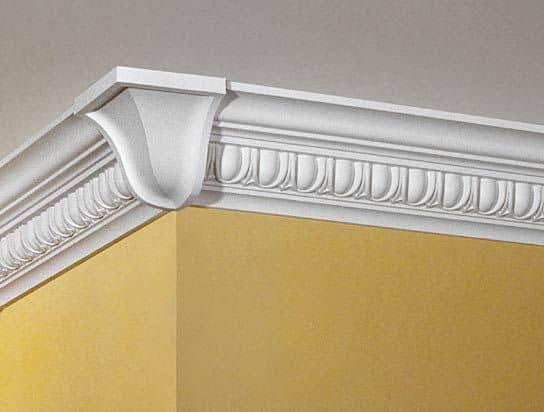
Egg and Dart Crown Molding
Egg and dart patterns are quite common for moldings, but it is also widely used for exterior architecture as well as outdoor constructions.
Egg and dart molding is commonly used in designs that also include chair rails or crown molding.
The mold has different V-darts with oval-shaped eggs, whether split or whole, that are informed by ancient Greek style. Ancient Greece is where the egg and dart patterns originally developed.
7. Wainscoting

Wainscoting Crown Molding
To cover the lowest three to four feet of your walls, wainscoting is a stylish molding that can be placed between both the chair rail and baseboard.
Wainscoting gives your walls depth as well as beauty by framing them with raised decorative features.
Despite wainscoting is not extremely popular, it can bring uniqueness to a room. It is considered one of the most accessible trim molding styles, having a wide range of styles to choose from.
8. Chair Rail
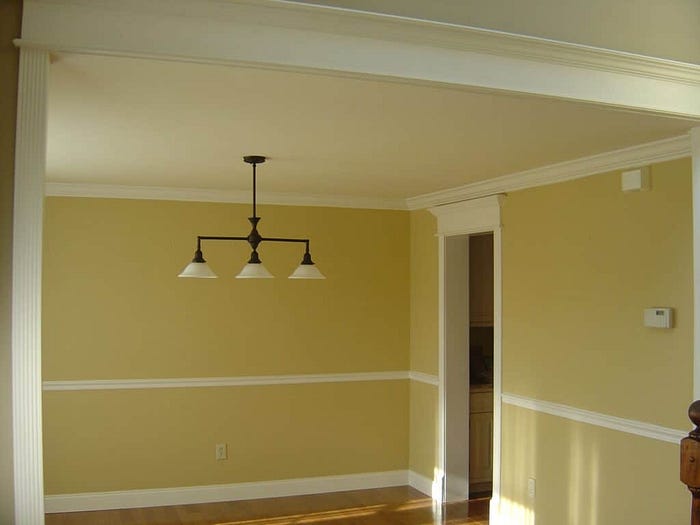
Chair rail
The chair rail is a style of trim that protects your walls from chairs touching it while also being aesthetically pleasing, generally in a dining room. Chair rails are commonly used for decoration.
They provide charm and warmth to the room while preventing the walls from scratches and damage. In order to transition between two various types of wall surfaces, it can also be utilized just for aesthetic reasons.
The popular design technique is to paint one side of the chair rail as well as wallpaper on the another. For a unique effect, you may use a different paint color, wallpaper design, or wall paneling for the portion of a wall that is below the chair rail.
9. Bead and Pearl
The bead and pearl moldings are the same styles that can be seen in a wide range of home fittings, such as trim and stair railings.
They are made up of rows with symmetrical spherical patterns. These moldings can have varying amounts of detail. The beads usually adopt the shape of items which include leaves, spindles, or darts.
The crown molding and chair rails are commonly decorated with bead and pearl patterns.
10. Baseboard

Baseboard molding
In the majority of homes, baseboard molding is common. The baseboard is a plain finish that runs down the base of your wall, just above the floor.
it is utilized to provide an attractive and protective border. In a contrast to crown molding, the simple baseboard is also a very popular style of trim.
It can be plain or decorated whenever combined with a quarter round or different types of trim. Baseboards are often thinner, compared to casings. Combining the two will result in a smooth appearance.
Ensure that the style of your baseboards matches and does not conflict with the crown molding or decor above.
11. Picture Rail
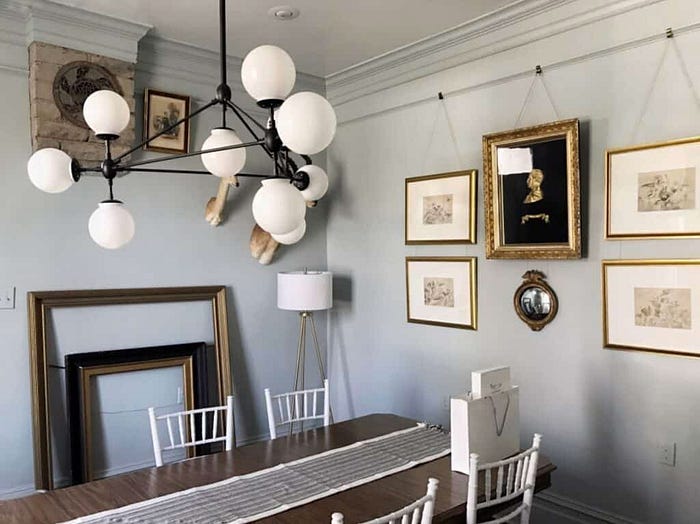
Picture Rail Molding
The picture rail’s function is similar to that of a chair rail. You can hold paintings from it without damaging your walls because your screw is into the molding instead of the wall as they are placed a foot or two just below the ceiling. The picture rails are a style of molding that is positioned horizontally.
Additionally, it could be utilized to clarify a central focus on a wall or to provide a detailed and ornate framework for canvases.
The picture rail has grown into a distinct decorative component throughout time.
Types Of Crown Molding Materials
There are various materials available for crown molding. The person’s own choice or financial restrictions are usually the main criteria when selecting between two options.
Examine each material to get an idea of which approach you would like for your house.
Wood

Wood Crown Molding
The most traditional form of crown molding is wood crown molding. If cost is not a consideration, natural wood is commonly the desired molding material.
It is not a material that everyone can pick up as well as deal with effectively because it requires expertise while going for cutting and placing.
It is created from a variety of wood types and it is available in a range of styles and finishes. It provides your room with a smooth and natural appearance which is hard to achieve with other materials.
MDF
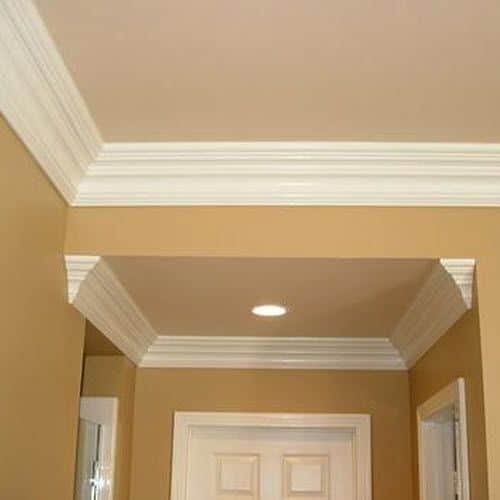
MDF Crown Molding
MDF crown molding, which means “Medium Density Fiberboard,” is a combination made of sawdust and resins that have been crushed together.
The Primed medium-density fiberboard is a desirable option that is reasonably priced. It can be easily coated as well as comes in a thin veneer that can be stained.
MDF is a fantastic choice for living rooms as well as dining rooms equal due to its strength and adaptability to suit cabinets or flooring. MDF is inexpensive, lightweight, and simple to use.
Plaster
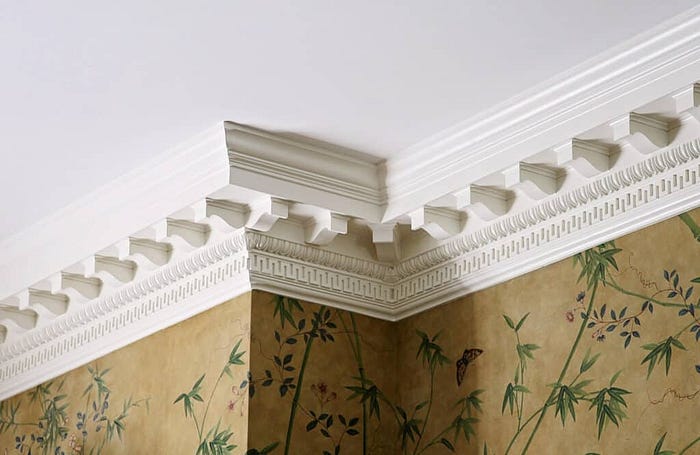
Plaster Molding
Plaster is a popular material for crown molding, just like wood. The plaster crown molding performs effectively in larger ornate designs with high ceilings, including two-story entry points, where it draws attention and produces a dramatic effect.
The plaster crown is expensive and needs to be installed by an expert. The cast material generates intricate features which are difficult to achieve with wood, and it does not shrink.
The installation and maintenance of plaster crown molding need careful handling due to its weight.
Metal
Metal crown molding is a fantastic option if you are looking for a highly distinct look in your house and are not against employing an expert to finish the installation for your home even though it is not a highly popular type of crown molding.
However, it is not an ideal material for the average householder to place because you need to avoid damaging the crown molding when placing it, as this can have a significant impact on how your room looks after it is completed.
PVC
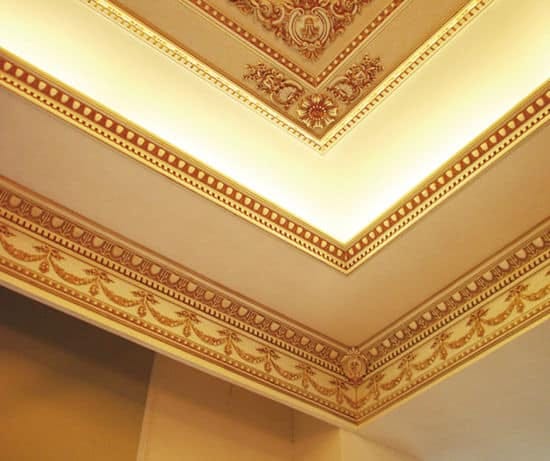
PVC Crown Molding
The PVC crown molding is suitable for use in bathrooms, outdoors, or any place water is a certainty.
PVC is a thermoplastic substance that is quite close to polyurethane.PVC has limited design choices than customizable plaster or wood.
It can be challenging to paint due to its slick surface, but painting is necessary to hide the plastic-like appearance. This product won’t twist or decay even if it gets quite moist because PVC is basically plastic.
Rubber Or Flex

Flexible Molding
This substance is extremely flexible, just as its names indicate. The rubber crown molding is a flexible and lightweight choice for curved areas.
It is quite functional but not particularly durable, making it prone to tears and cuts if not handled with attention.
Moreover, rubber has a natural shine that makes its surface appear less polished compared to other materials. The rubber shine of flex can be difficult to conceal and it needs a priming and paint finish.
Polyurethane
It is less costly compared to wood, but it is highly durable as well as resistant to insect and decay damage. Polyurethane is used in the majority of home areas and it is trouble-free.
It can be fixed with adhesive and is less expensive compared to others, but it will need several layers of paint and can easily be dented.
If you wish the appearance of painted wood, this is a wonderful all-around material. Rubber and plastic are combined to create lightweight polyurethane crown molding.
Polystyrene

Polystyrene Crown Molding
If you want to modify your room fast and do not have a substantial amount of money or time to spend on the task, this kind of crown molding is excellent.
Construction adhesive is used to fix this material rather than nails as well as there is no requirement to polish the crown molding because it is extremely light and foamy and therefore, it is simple to cut with a sharp knife or set of scissors.
Uses Of Crown Moldings
Nowadays, crown molding is mainly used for decoration.
